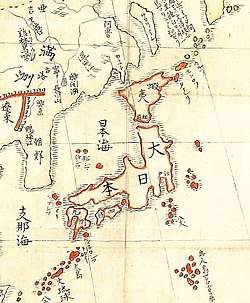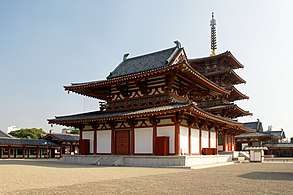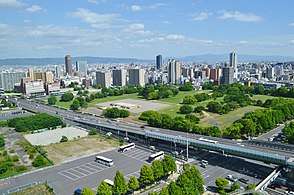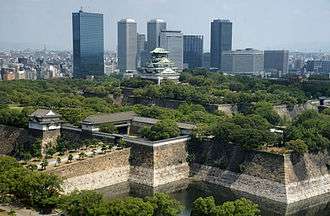Timeline of Osaka
Prior to 19th century
| History of Japan |
|---|
 |
.jpg)
Map of Osaka in 1686 CE
- 211 CE – Sumiyoshi taisha (shrine) founded.
- 593 CE – Shitennō-ji (temples) founded.
- 645 CE – Capital of Japan relocated to Naniwa-kyō;[1] Kōtoku in power.
- 672 – Tenmu in power.[2]
- 724 – Shōmu in power.[2]
- 794 – Japanese capital relocated from Naniwa to Heian-kyō.[2]
- 1496 – Ishiyama Hongan-ji construction begins (approximate date).[3][4]
- 1583 – Osaka Castle construction begins.[4]
- 1614 – November: Siege of Osaka begins.
- 1615
- June: Siege of Osaka ends.
- Dōtonbori (canal) built.
- 1684 – Takemoto-za puppet theatre opens.[5]
- 1720 – Sasa-se theatre fan club founded.[6]
- 1724 – Kaitokudō merchant academy established.[7]
- Gallery
 Sumiyoshi Taisha Grand Shrine
Sumiyoshi Taisha Grand Shrine
 Remains of Naniwa-no-Miya Palace (2017)
Remains of Naniwa-no-Miya Palace (2017)
19th century
.jpg)
Osaka Japan in 1880s
Sennichimae area in 1916
- 1805 – Bunrakuza puppet theatre opens (approximate date).[5]
- 1837 – Economic/social unrest led by Ōshio Heihachirō.[1]
- 1838 – Tekijuku (school) opens.[5]
- 1868
- European commerce begins.[8]
- City becomes part of Osaka Municipal Prefecture.[5]
- 1869 – Tokyo-Osaka steamship line begins operating.[9]
- 1871
- Tokyo-Kyoto-Osaka postal service begins.[10]
- Imperial Mint built.[11][12]
- 1874 – Kobe-Osaka railway begins operating;[13] Ōsaka Station (with clocktower) opens.[14]
- 1875 – Meiji political Osaka Conference of 1875 held.
- 1876 – Osaka Nippō (newspaper) begins publication.
- 1878 – Osaka Stock Exchange and Osaka Chamber of Commerce [15] established.
- 1879 – Asahi Shimbun (newspaper) begins publication.[16]
- 1880 – Osaka Commercial Training Institute established.
- 1881 – Osaka Iron Works established.[9][17]
- 1882
- Osaka Boseki Kaisha (spinning mill) in business.
- Population: 332,425.[4]
- 1884 – Osaka Shosen Kaisha (shipping firm) in business.[18]
- 1887 – Population: 426,846.[4]
- 1888 – Osaka Mainichi Shinbun (newspaper) begins publication.[19]
- 1890 – Nakanoshima Park opens.[12]
- 1892
- 1895
- Sumitomo Bank established.[20][21]
- Kyōbashi Station built.
- 1897
- 1900 – Population: 881,344 city; 1,678,422 prefecture.[24]
20th century

Osaka castle

Skyscrapers in Umeda district
Sennichimae area in 1916
1900s–1940s
- 1901 – Satirical Kokkei Shinbun begins publication.[25][26]
- 1903 – National Industrial Exposition (Japan) held in Osaka.[27][4]
- 1904 – Osaka Prefectural Nakanoshima Library opens.
- 1905 – Maruki-go bakery in business.[28]
- 1909 – Tennōji Park established.
- 1910 – Population: 1,239,373 city; 2,197,201 prefecture.[24]
- 1915 – Tennōji Zoo founded.[29]
- 1917 – City planning committee formed.[13]
- 1918
- 1919 – Miki Hall (concert venue) opens.[30]
- 1920
- 1922 – Daimaru department store built.[28]
- 1923
- 1924 – Osaka Photographic Science Society founded.[34]
- 1925
- City wards established: Higashinari, Higashiyodogawa, Konohana, Minato, Naniwa, Nishinari, Nishiyodogawa, Sumiyoshi, and Tennōji.
- "Public radio broadcasting commences."[16]
- Nomura Securities Co., Ltd. established.
- Population: 2,114,804.[31]
- 1926 – Asahi Kaikan (concert hall) opens.[30]
- 1927 – Dojima Ohashi (bridge) built over Dojima River.[17]
- 1928 – Osaka University of Commerce active.
- 1929
- Kosobe Conservatory (garden) established.[35]
- Hankyu Department Store opens in Umeda Station.
- 1930 – Population: 2,453,573 city; 3,540,017 prefecture.[24]
- 1931 – National Defense Women's Association founded in Osaka.[10][36]
- 1932 – City wards established: Asahi and Taishō.
- 1933
- Subway Midōsuji Line begins operating.
- Sanwa Bank established.[21]
- 1936
- Osaka Tigers baseball team formed.
- Osaka Municipal Museum of Art opens.
- 1940
- January 28: Train crash at Ajikawaguchi Station.[11]
- Population: 3,252,340 city;[37] 4,843,032 prefecture.[24]
- 1942
- Osaka Shimbun (newspaper) in publication.[15]
- Subway Yotsubashi Line begins operating.
- 1943
- City wards established: Abeno, Fukushima, Higashisumiyoshi, Ikuno, Jōtō, and Miyakojima.
- Hitachi Zosen Corporation in business.[17]
- 1945
- March 13: Bombing of Osaka during World War II begins.
- August 14: Bombing of Osaka ends.
- Population: 1,102,959.[38]
- Osaka Municipal Transportation Bureau established.
- 1947
- Kansai Symphony Orchestra founded.
- Population: 1,559,310.[37]
- 1948 – Grand Sumo tournament begins.[39]
- 1949 – Osaka City University and Osaka Securities Exchange[15] active.
1950s–1990s
- 1950 – Population: 1,956,136.[38]
- 1955
- Cinerama Gekijo opens.[40]
- Sankei Sports newspaper begins publication.[15]
- Population: 2,547,321.[31]
- 1956
- Tsūtenkaku (tower) built.
- Osaka designated a government ordinance city.[41]
- 1957 – Sister city relationship established with San Francisco, USA.[42]
- 1958 – Radio Osaka begins broadcasting.
- 1961
- September: Typhoon Muroto II occurs.[11]
- Subway Chūō Line begins operating.
- 1964
- Tokyo-Osaka Tōkaidō Shinkansen (hi-speed train) begins operating.[11]
- Nagai Stadium opens.
- 1967 – Subway Tanimachi Line begins operating.
- 1968 – Osaka Sports newspaper in publication.[15]
- 1969 – Subway Sakaisuji Line and Sennichimae Line begin operating.
- 1970
- 1972
- May 13: Sennichi Department Store Building fire.
- Osaka Expo '70 Stadium opens.
- 1974 – City wards established: Hirano, Suminoe, Tsurumi, and Yodogawa.
- 1975 – Population: 2,780,000.[44]
- 1977 – National Museum of Art, Osaka opens.
- 1979 – Capsule Inn Osaka in business.[45]
- 1980 – Osaka Symphony Orchestra established.[46]
- 1982
- Osaka International Ladies Marathon begins.
- Museum of Oriental Ceramics, Osaka established.
- 1983 – Osaka-jō Hall (arena) opens.
- 1984 – National Bunraku Theatre opens.[2]
- 1987 – Kincho Stadium opens.
- 1989
- City wards established: Chūō and Kita.
- Osaka Science Museum opens.
- 1990
- Subway Nagahori Tsurumi-ryokuchi Line begins operating.
- Osaka Aquarium Kaiyukan opens.
- Garden and Greenery Exposition held in city.[47]
- 1993 – Umeda Sky Building constructed.
- 1995
- January 17: The 6.9 Mw Great Hanshin earthquake shakes the southern Hyōgo Prefecture with a maximum Shindo of VII, leaving 5,502–6,434 people dead, and 251,301–310,000 displaced in the region.
- Takafumi Isomura becomes mayor.
- 1996 – Osaka Prefectural Central Library opens.[48]
- 1997 – Tempozan Ferris Wheel and Kyocera Dome open.
- 1999 – Momofuku Ando Instant Ramen Museum opens in nearby Ikeda.
21st century
- 2001 – June 8: Osaka school massacre occurs in nearby Ikeda.
- 2006 – Subway Imazatosuji Line begins operating.
- 2007 – Kunio Hiramatsu becomes mayor.
- 2009 – Kansai Music Conference begins.
- 2010 – Population: 2,665,314.[49]
- 2011 – Tōru Hashimoto becomes mayor.[50]
- 2013 – Festival Hall opens.
- 2014 – Population: 2,685,218.[51]
gollark: ++tel info
gollark: CEASE hanguping.
gollark: No.
gollark: Esolangs is YanksTowelBegin.
gollark: ++tel status
See also
- Osaka history
- Osaka history (in Japanese; includes timeline)
- List of mayors of Osaka
References
- Kenneth Henshall (2014). "Chronology". Historical Dictionary of Japan to 1945. USA: Scarecrow Press. ISBN 978-0-8108-7872-3.
- Schellinger 1996.
- Mark L. Blum and Shin'ya Yasutomi, ed. (2006). "Chronology of Rennyo's Life". Rennyo and the Roots of Modern Japanese Buddhism. Oxford University Press. ISBN 978-0-19-535099-9.
- Souvenir 1903.
- McClain 1999.
- Matsudaira 1984.
- Christine Guth (1996). "Timeline". Art of Edo Japan: The Artist and the City 1615–1868. Yale University Press. ISBN 978-0-300-16413-8.
- Benjamin Vincent (1910), "Japan", Haydn's Dictionary of Dates (25th ed.), London: Ward, Lock & Co., hdl:2027/loc.ark:/13960/t89g6g776 – via Hathi Trust
- G. C. Allen (1946). Short Economic History of Modern Japan, 1867–1937. Routledge. ISBN 978-0-415-31303-2.
- "Timeline of Modern Japan (1868–1945)". About Japan: A Teacher's Resource. New York: Japan Society.
- Bruce Wetterau (1990), New York Public Library Book of Chronologies, New York: Prentice Hall, OL 1885709M
- Ruble 2001.
- André Sorensen (2002). The Making of Urban Japan: Cities and Planning from Edo to the Twenty First Century. Japanese Studies Series. Routledge. ISBN 978-1-134-73657-7.
- Hoshimi Uchida (2002). "Spread of Timepieces in the Meiji Period". Japan Review (14 (Birth of Tardiness: The Formation of Time Consciousness in Modern Japan)): 173–192. JSTOR 25791261.
- "Japan". Europa World Year Book. Europa Publications. 2004. ISBN 978-1-85743-254-1.
- Yoshio Sugimoto, ed. (2009). "Chronology". Cambridge Companion to Modern Japanese Culture. Cambridge University Press. ISBN 978-1-107-49546-3.
- "Corporate Chronology". Osaka: Hitachi Zosen Corporation. Retrieved July 30, 2015.
- Department of Finance (1904). Financial and Economical Annual of Japan. Tokyo: Government Printing Office – via Hathi Trust.
- Altman 1990.
- Glyn Davies; Roy Davies (2002). "Comparative Chronology of Money" – via University of Exeter.
- Norio Tamaki (1995). "Genealogy of leading Japanese banks, 1859–1959". Japanese Banking: A History, 1859–1959. Cambridge University Press. ISBN 978-0-521-02233-0.
- Mosk 2001.
- Jasper Sharp (2011). "Chronology". Historical Dictionary of Japanese Cinema. Scarecrow Press. ISBN 978-0-8108-7541-8.
- Statistics 1941.
- "Japanese Humor and Caricature", The Bookman, New York, July 1904, hdl:2027/njp.32101077276929
- Hans Harder and Barbara Mittler, ed. (2013). Asian Punches: a Transcultural Affair. Springer. ISBN 978-3-642-28607-0.
- "Expositions: where the modern technology of the times was exhibited". Tokyo: National Diet Library. 2011.
- Kazuo Usui (2014). Marketing and Consumption in Modern Japan. Routledge. ISBN 978-1-134-35074-2.
- Vernon N. Kisling, ed. (2000). "Zoological Gardens of Japan (chronological list)". Zoo and Aquarium History. USA: CRC Press. ISBN 978-1-4200-3924-5.
- Hugh de Ferranti and Alison Tokita, ed. (2013). Music, Modernity and Locality in Prewar Japan: Osaka and Beyond. Ashgate. ISBN 978-1-4724-0989-8.
- Ayanori Okasaki (1957). "Growth of Urban Population in Japan". Genus. 13 (1/4): 132–152. JSTOR 29787368.
- "Corporate Info: Chronology". Osaka: Sharp Corporation. Retrieved July 30, 2015.
- Hanes 2002.
- "Chronology". History of Japanese Photography. USA: Museum of Fine Arts, Houston. 2003. ISBN 978-0-300-09925-6.
- "Garden Search: Japan". London: Botanic Gardens Conservation International. Retrieved July 30, 2015.
- Gregory James Kasza (1995). The Conscription Society: Administered Mass Organizations. Yale University Press. ISBN 978-0-300-06242-7.
- Leon E. Seltzer, ed. (1952), Columbia Lippincott Gazetteer of the World, New York: Columbia University Press, p. 1394, OL 6112221M
- "Population of capital city and cities of 100,000 or more inhabitants". Demographic Yearbook 1955. New York: Statistical Office of the United Nations.
- J.A. Sargeant (1959). Sumo: the Sport and the Tradition. Charles E. Tuttle Co. ISBN 978-1-4629-0422-8.
- "Movie Theaters in Osaka". CinemaTreasures.org. Los Angeles: Cinema Treasures LLC. Retrieved July 30, 2015.
- Philip Shapira; et al., eds. (1994). Planning for Cities and Regions in Japan. Liverpool University Press. ISBN 978-0-85323-248-3.
- "San Francisco Sister Cities". USA: City & County of San Francisco. Retrieved December 1, 2015.
- Gary D. Allinson (2004). "Chronology". Japan's Postwar History (2nd ed.). Cornell University Press. ISBN 0-8014-8912-1.
- United Nations Department of Economic and Social Affairs, Statistical Office (1976). "Population of capital city and cities of 100,000 and more inhabitants". Demographic Yearbook 1975. New York. pp. 253–279.
- "Sleep Tight", The Economist, August 22, 2014
- Colin Lawson, ed. (2003). "Orchestras Founded in the 20th Century (chronological list)". Cambridge Companion to the Orchestra. Cambridge University Press. ISBN 978-0-521-00132-8.
- Brian Moeran (1996). "Chronology of Japanese Advertising and Media from 1862 to 1991". A Japanese Advertising Agency: An Anthropology of Media and Markets. University of Hawaii Press. ISBN 978-1-136-79533-6.
- "Institutions in Japan: Browse by Region (Kinki)". Research Access in Japanese Museums, Libraries, and Archives Resources. North American Coordinating Council on Japanese Library Resources. Retrieved July 30, 2015.
- "Population of Capital Cities and Cities of 100,000 or More Inhabitants". Demographic Yearbook 2013. United Nations Statistics Division.
- "Japanese Mayors". City Mayors.com. London: City Mayors Foundation. Retrieved July 30, 2015.
- "About Osaka City". City of Osaka. Retrieved July 30, 2015.
This article incorporates information from the Japanese Wikipedia.
Bibliography
- Published in the 19th century
- Philipp Franz von Siebold (1841). "(Ohosaka)". Manners and Customs of the Japanese, in the Nineteenth Century. London: John Murray. hdl:2027/hvd.hw26ti – via Hathi Trust.
- Published in the 20th century
- "Osaka". Guide Book for Tourists in Japan. Yokohama: Obun Printing Co. 1903.
- Souvenir Guide to Osaka and the Fifth National Industrial Exhibition. Hakurankwai Kyosankwai. 1903.
- "Osaka", Encyclopædia Britannica (11th ed.), New York, 1910, OCLC 14782424
- "Osaka (Settsu)", Handbook for Travellers in Japan (9th ed.), London: J. Murray, 1913, hdl:2027/nnc1.50290956
- T. Philip Terry (1914), "Osaka", Terry's Japanese Empire, Boston: Houghton Mifflin, LCCN 14005129
- Robert P. Porter (1915), "The Larger Cities: Osaka", Japan, the New World-Power (2nd ed.), London: Oxford University Press
- Claudius Madrolle (1916). "Osaka". Chine du Sud, Java, Japon (in French) (2nd ed.). Paris: Hachette. hdl:2027/uc1.$b193211.
- Osaka-fu tokeisho: 1940 [Osaka Prefecture Statistics] (in Japanese), Osaka-fu, 1941
- W.A. Robson, ed. (1954). "Tokyo and Osaka". Great Cities of the World: their Government, Politics and Planning. Routledge. pp. 719–754. ISBN 978-1-135-67247-8.
- William B. Hauser (1977), "Osaka: A Commercial City in Tokugawa Japan", Urbanism Past and Present, 5, ISSN 0160-2780
- S. Matsudaira (1984). "Hiiki Renchū (Theatre Fan Clubs) in Osaka in the Early Nineteenth Century". Modern Asian Studies. 18 (4): 699–709. doi:10.1017/s0026749x00016395. JSTOR 312345.
- Albert Altman (1990). "The proprietors assert themselves: the Osaka Asahi shinbun and the Osaka Mainichi shinbun in the late nineteenth century". In Peter Lowe and Herman Moeshart (ed.). Western Interactions With Japan: Expansions, the Armed Forces and Readjustment 1859–1956. Japan Library. ISBN 978-1-135-88102-3.
- Kuniko Fujita and Richard Child Hill, ed. (1993). "Osaka and Tokyo Compared". Japanese Cities. USA: Temple University Press. ISBN 978-1-4399-0092-5.
- Schellinger and Salkin, ed. (1996). "Osaka". International Dictionary of Historic Places: Asia and Oceania. UK: Routledge. p. 648+. ISBN 9781884964046.
- James L. McClain and Wikita Osamu, ed. (1999). "Chronology". Osaka: The Merchants' Capital of Early Modern Japan. Cornell University Press. ISBN 0-8014-3630-3.
- Ian Martin Röpke (1999). Historical Dictionary of Osaka and Kyoto. Historical Dictionaries of Cities of the World. Maryland, USA: Scarecrow Press. ISBN 978-0-8108-3622-8.
- Published in the 21st century
- Carl Mosk (2001). "Manchester of the Far East". Japanese Industrial History: Technology, Urbanization, and Economic Growth. M.E. Sharpe. ISBN 978-0-7656-3855-7.
- Blair A. Ruble (2001). Second Metropolis: Pragmatic Pluralism in Gilded Age Chicago, Silver Age Moscow, and Meiji Osaka. Cambridge University Press. ISBN 978-0-521-80179-9.
- Jeffrey E. Hanes (2002). The City As Subject: Seki Hajime and the Reinvention of Modern Osaka. University of California Press. ISBN 978-0-520-92683-7.
- Richard Tames (2008). "Historical Gazetteer: Osaka". A Traveller's History of Japan (4th ed.). USA: Interlink Books. ISBN 978-1-56656-404-5.
- Hugh Cortazzi, ed. (2012). "Osaka". Victorians in Japan: In and Around the Treaty Ports. Bloomsbury. pp. 137–. ISBN 978-1-78093-977-3. (first published in 1987)
External links
| Wikimedia Commons has media related to Osaka. |
- Items related to Osaka, various dates (via Europeana).
- Items related to Osaka, various dates (via Digital Public Library of America).
This article is issued from Wikipedia. The text is licensed under Creative Commons - Attribution - Sharealike. Additional terms may apply for the media files.